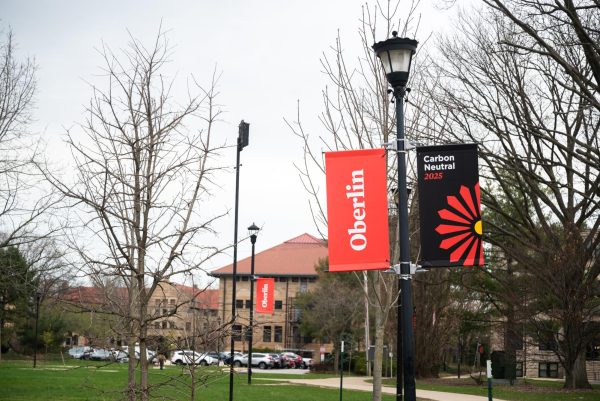Winter Term to Be Restructured With AAPR
Oberlin administrators have been working to create a more structured, equitable Winter Term model in response to the preliminary AAPR recommendations first detailed in March. Future changes include increasing the number of students and professors on campus and increasing the breadth and variety of courses offered.
AAPR steering committee members hope that as many as one-third of the student body may remain on campus during future Winter Terms.
“[An increased number of students on campus is] a way to maximize use of the institution’s resources and to build a stronger sense of community through shared experiences and organized social events,” according to the AAPR’s Summary of Work to Date document, made public to students on March 29.
Student Senate and an internal review by the Winter Term office also came to similar conclusions about the necessary changes to Winter Term, as they concluded some students weren’t using the time in an academically or personally challenging way.
This would differ from prior Winter Terms, where most students leave campus, pursue independent projects or internships, or work in labs.
“Some students stay on campus [for Winter Term], but it’s a bit of a dead time,” said Renee Romano, professor of History, Comparative American Studies, and Africana Studies and chair of the History department.
Traditionally there have been limited academic or professional opportunities on campus during Winter Term. Associate Dean Laura Baudot hopes that future Winter Term offerings will create greater opportunities for career development.
“A liberal arts education is a fantastic foundation for any career students might want to go into, but sometimes courses that are more specially geared toward professional development give [students] the confidence that they need,” said Baudot. “Also, it’s just really interesting to explore the industry in a more concrete way.”
Baudot is currently working informally with the Career Center on a project called “Obiewood,” which will use Winter Term to connect students to the entertainment industry.
Associate Dean Elizabeth Hamilton also noted that the recommendations are focused on building up what is already happening on campus, including opportunities for community-based projects and learning practical skills. There is also a possibility that students could earn course credit toward distributional requirements over Winter Term, but this remains a preliminary suggestion.
“On-campus Winter Term group projects are great opportunities to delve into a topic and build community,” Hamilton wrote in an email to the Review. “Two that I know well are the Intensive Russian or German courses, models of immersion in learning. In a bigger Winter Term, we could enlarge the range of campus offerings and build in better resources for housing, dining, transportation, and social activities. I think that everyone would benefit from this. I really look forward to seeing what we can do.”
Romano also said there must be an intentional effort to increase the sense of community on campus during Winter Term with “money for social events, money for cultural events, [and] money for transportation.”
Another issue is that Winter Term opportunities are not evenly accessible to the student body, whether due to lack of financial resources, family connections, or support in the planning process.
“Oberlin is a ‘let every flower bloom’ kind of place, but we could give more support to the seedlings,” Romano said.
Hamilton suggested that a more robust advising program for Winter Term could bolster student experiences, including first-year students who may struggle to develop their first Winter Term project.
“From my perspective, student currently face several challenges with Winter Term, though often in very different ways and to varying degrees: The “blank canvas” is, for many, a golden opportunity, but for others, a truly daunting prospect,” Hamilton wrote. “When there are so many possibilities, how does a person actually design a meaningful project? Some clearer guidelines and models will help students to make the most of this time.”
Some students have noted that Winter Term funding is sparse, and securing funds can be complicated and too difficult to acquire given the time constraints.
“Another challenge stems from costs of projects, whether they’re individual or group projects, in the States or abroad,” Hamilton wrote. “Access to financial support is uneven, and the process of applying for funding is complicated and confusing.”
The proposed changes would also increase faculty involvement in Winter Term projects.
The AAPR recommendations suggest that faculty would be expected to sponsor one group project every four years. This would create more equity among faculty members, since some spend more time mentoring projects than others and have less time to work on personal projects.
The AAPR report also suggested that restructuring might open the door for ExCos to exist during Winter Term. College first-year Serena Zets, member of the ExCo committee and a student senator, expressed excitement about the idea but hesitation about its implementation.
“Offering Winter Term ExCos would require committee members to overwork ourselves even more and stay on campus over Winter Term to maintain the program,” Zets explained.
She fears that the burden of constructing more Winter Term programming may fall on students.
“Offering Winter Term ExCos seems like a thinly-veiled way to utilize the labor of the ExCo Committee and [its] student instructors to bail the College out from paying faculty to develop Winter Term intensives and stay on campus in January.”
No final decisions have been made about changes to Winter Term. Student Senate has a working group devoted to the issue and has been accepting student input through forms and surveys since the AAPR recommendations were announced. College second-year Bridget Smith, who formed the working group, says that she and fellow member David Seo gathered student input in a survey they administered to the student body. The Winter Term survey data will be published alongside the release of other AAPR data.






